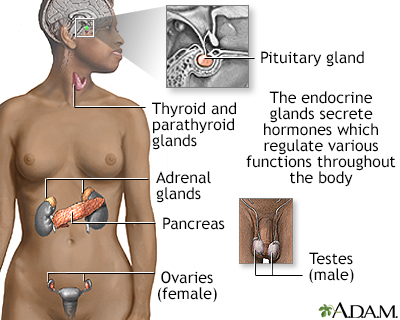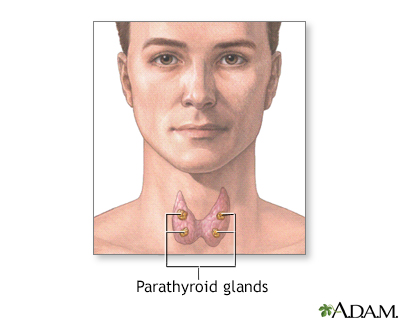Hypoparathyroidism
Parathyroid-related hypocalcemia
Hypoparathyroidism is a disorder in which the parathyroid glands in the neck do not produce enough parathyroid hormone (PTH).
Images


I Would Like to Learn About:
Causes
There are 4 tiny parathyroid glands in the neck, located near or attached to the back side of the thyroid gland.
The parathyroid glands help regulate calcium absorption, use, and removal by the body. They do this by producing PTH. PTH helps control calcium, phosphorus, and vitamin D levels in the blood and bone. It is important for healthy bones.
Hypoparathyroidism occurs when the glands produce too little PTH. The blood calcium level falls, and the phosphorus level rises.
The most common cause of hypoparathyroidism is injury to the parathyroid glands during thyroid or neck surgery. It may also be caused by any of the following:
- Autoimmune attack on the parathyroid glands (common)
- Very low magnesium level in the blood (reversible)
- Radioactive iodine treatment for hyperthyroidism (very rare)
DiGeorge syndrome is a disease in which hypoparathyroidism occurs because all the parathyroid glands are missing at birth. This disease includes other health problems besides hypoparathyroidism. It is usually diagnosed in childhood.
Familial hypoparathyroidism occurs with other endocrine diseases such as adrenal insufficiency in a syndrome called type I polyglandular autoimmune syndrome (PGA I).
Symptoms
Onset of the disease is very gradual and symptoms can be mild. Many people diagnosed with hypoparathyroidism have had symptoms for years before they are diagnosed. Symptoms may be so mild that the diagnosis is made after a screening blood test that shows low calcium.
Symptoms may include any of the following:
- Tingling lips, fingers, and toes (most common)
- Muscle cramps (most common)
- Muscle spasms called tetany (can affect the larynx, causing breathing difficulties)
- Abdominal pain
- Abnormal heart rhythm
- Brittle nails
- Cataracts
- Calcium deposits in some tissues
- Decreased consciousness
- Dry hair
- Dry, scaly skin
- Pain in the face, legs, and feet
- Painful menstruation
- Seizures
- Teeth that do not grow in on time, or at all
- Weakened tooth enamel (in children)
Exams and Tests
Your health care provider will do a physical exam and ask about symptoms.
Tests that will be done include:
Other tests that may be ordered include:
- Electrocardiogram (ECG) to check for an abnormal heart rhythm
- Computed tomography (CT) scan to check for calcium deposits in the brain
Treatment
The goal of treatment is to reduce symptoms and restore the calcium and mineral balance in the body.
Treatment involves calcium carbonate and vitamin D supplements. These usually must be taken for life. Blood levels are measured regularly to make sure that the dose is correct. A high-calcium, low-phosphorous diet is recommended.
Injections of PTH may be recommended for some people. Your provider can tell you if this medicine is right for you.
People who have life-threatening attacks of low calcium levels or prolonged muscle contractions are given calcium through a vein (IV). Precautions are taken to prevent seizures or larynx spasms. Your heart is monitored for abnormal rhythms until you are stable. When the life-threatening attack has been controlled, treatment continues with medicine taken by mouth.
Outlook (Prognosis)
The outcome is likely to be good if the diagnosis is made early. But changes in the teeth, cataracts, and brain calcifications cannot be reversed in children who have undiagnosed hypoparathyroidism during development.
Possible Complications
Hypoparathyroidism in children may lead to poor growth, abnormal teeth, and slow mental development.
Too much treatment with vitamin D and calcium can cause high blood calcium (hypercalcemia) or high urine calcium (hypercalciuria). Excess treatment may sometimes interfere with kidney function, or even cause kidney failure.
Hypoparathyroidism increases the risk for:
- Addison disease (only if the cause is autoimmune)
- Cataracts
- Parkinson disease
- Pernicious anemia (only if the cause is autoimmune)
When to Contact a Medical Professional
Contact your provider if you develop any symptoms of hypoparathyroidism.
Seizures or breathing problems are an emergency. Call 911 or the local emergency number right away.
Related Information
Parathyroid hormone (PTH) blood testHyperthyroidism
Endocrine glands
Addison disease
Tracheostomy
Hypercalcemia
Pernicious anemia
Parkinson disease
References
Husebye E, Weetman AP. Autoimmune polyglandular syndromes. In: Robertson RP, ed. DeGroot's Endocrinology. 8th ed. Philadelphia, PA: Elsevier; 2023:chap 132.
Reid LM, Kamani D, Randolph GW. Management of parathyroid disorders. In: Flint PW, Francis HW, Haughey BH, et al, eds. Cummings Otolaryngology: Head and Neck Surgery. 7th ed. Philadelphia, PA: Elsevier; 2021:chap 123.
Thakker RV. The parathyroid glands, hypercalcemia, and hypocalcemia. In: Goldman L, Cooney KA, eds. Goldman-Cecil Medicine. 27th ed. Philadelphia, PA: Elsevier; 2024:chap 227.
BACK TO TOPReview Date: 5/20/2024
Reviewed By: Sandeep K. Dhaliwal, MD, board-certified in Diabetes, Endocrinology, and Metabolism, Springfield, VA. Also reviewed by David C. Dugdale, MD, Medical Director, Brenda Conaway, Editorial Director, and the A.D.A.M. Editorial team.

Health Content Provider
06/01/2025
|
A.D.A.M., Inc. is accredited by URAC, for Health Content Provider (www.urac.org). URAC's accreditation program is an independent audit to verify that A.D.A.M. follows rigorous standards of quality and accountability. A.D.A.M. is among the first to achieve this important distinction for online health information and services. Learn more about A.D.A.M.'s editorial policy, editorial process and privacy policy. A.D.A.M. is also a founding member of Hi-Ethics. This site complied with the HONcode standard for trustworthy health information from 1995 to 2022, after which HON (Health On the Net, a not-for-profit organization that promoted transparent and reliable health information online) was discontinued. |
The information provided herein should not be used during any medical emergency or for the diagnosis or treatment of any medical condition. A licensed medical professional should be consulted for diagnosis and treatment of any and all medical conditions. Links to other sites are provided for information only -- they do not constitute endorsements of those other sites. © 1997- 2025 A.D.A.M., a business unit of Ebix, Inc. Any duplication or distribution of the information contained herein is strictly prohibited.
